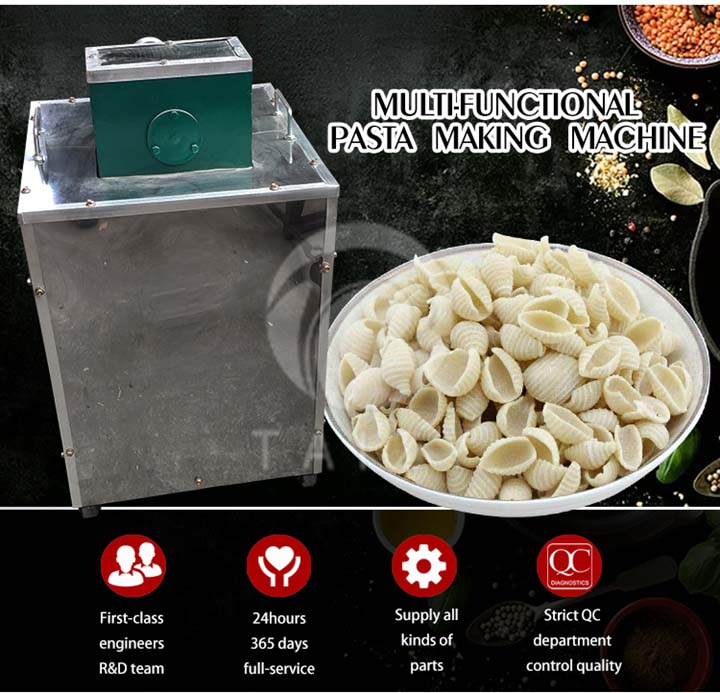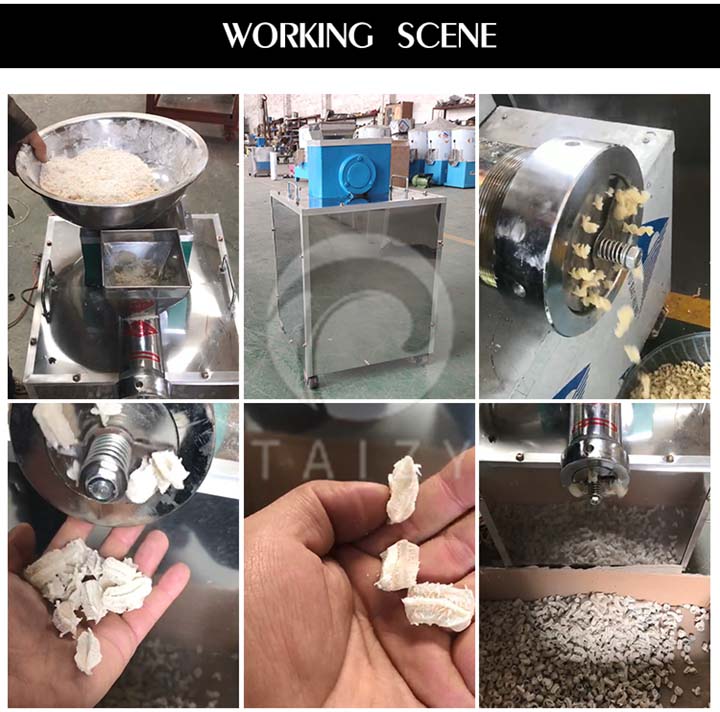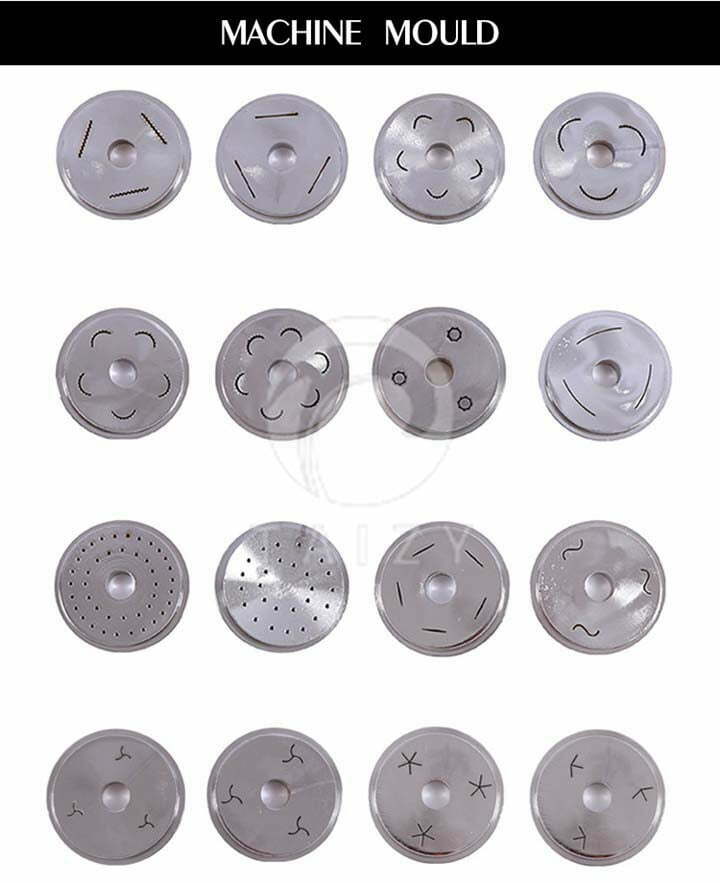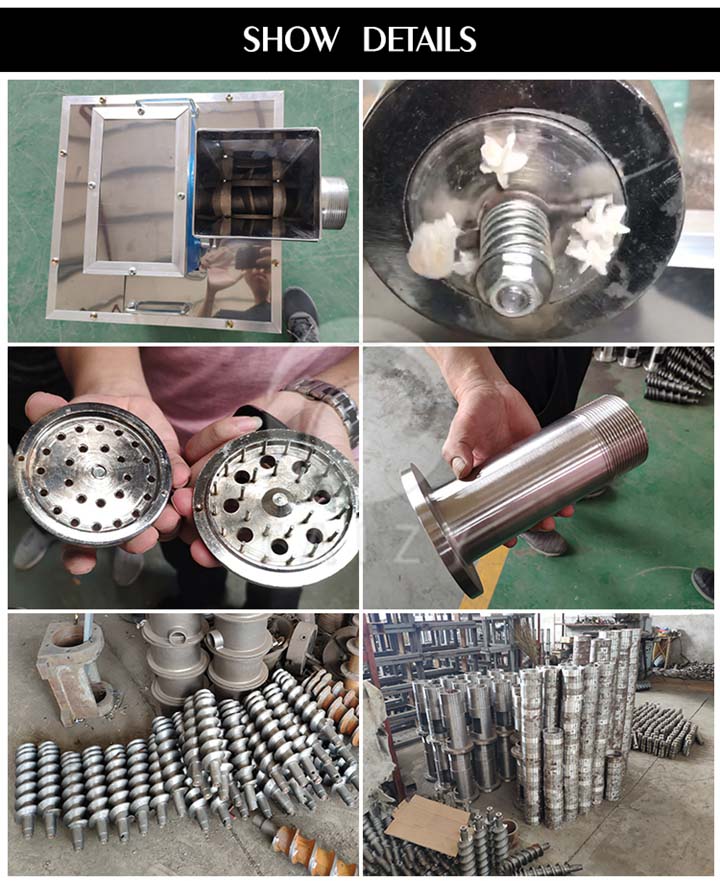Die industrielle Nudelmaschine kann verschiedene Nudeln mit unterschiedlichen Formen wie Muscheln, weißem Pilz, fünf Sternen, Muscheln, Spiralnudeln, Laternen usw. herstellen. Sie kann nach den Anforderungen des Benutzers angepasst werden. Die elektrische Nudelmaschine ist in der Herstellung exquisit und in der Struktur vernünftig, mit niedrigen Kosten und hohem Ertrag. Sie können diese Nudelmaschine ohne zu zögern wählen, wenn Sie ein Nudelgeschäft starten möchten, und wir werden Ihnen beibringen, wie man sie benutzt und Ihnen das Rezept kostenlos zur Verfügung stellen. Pasta-Maschine ist einfach zu bedienen.
Video zur Funktionsweise einer industriellen Nudelmaschine

Technische Parameter der elektrischen Nudelmaschine
| Modell | PA-60 | PA-80 | PA-100 | PA-130 Einzelkopf | 130 Doppelkopf |
| Spannung/V | 220 | 380 | 380 | 380 | 380 |
| Leistung/kW | 1.5-2.2 | 3 kW | 4 kW | 5.5 | 11 |
| Gewicht/kg | 70 | 80 | 100 | 300 | 600 |
| Größe/mm | 420*600*760 | 500*700*800 | 500*750*900 | 1000*900*700 | 1500*1000*850 |
| Kapazität kg/h | 15-20 | 30-50 | 60-70 | 75-110 | 150-220 |
| Formpreis | 40 | 70 | 100 | 200 | 200 |

Vorteil einer kommerziellen Nudelmaschine
- Es gibt verschiedene Formen, die Sie je nach Bedarf anpassen können.
- Die fertigen Nudeln mit verschiedenen und niedlichen Formen, die die Aufmerksamkeit der Leute auf sich ziehen und Ihren Nutzen steigern.
- Nudelmaschine ist einfach zu bedienen.

Wie benutzt man eine industrielle Nudelmaschine?
- Öffnen Sie die Mutter mit einem Spezialschlüssel und nehmen Sie den Spiralstab heraus.
- Reinigen Sie den Teigeimer und den Spiralstab und stecken Sie diese dann in die Hülse.
- Der Antriebskeil an der Spiralstange wird auf den Schlitz der „Drehhülse“ ausgerichtet und am Reinigungswerkzeug installiert.
- Schrauben Sie die Mutter fest und ziehen Sie sie mit einem Spezialschlüssel fest. Schalten Sie den Strom ein, die Nudelmaschine kann nach einigen Minuten im Leerlauf ohne ungewöhnliche Geräusche verwendet werden.
Hinweis: Entfernen Sie nach dem Gebrauch die Mutter und nehmen Sie das Werkzeug heraus, um sie in das Wasser einzuweichen, wodurch der verbleibende Nudelblock auf der Nudelmaschine entfernt werden kann. Die Schlacke in der Mutter sollte nach mehreren Minuten Leerlauf entfernt werden. Ungereinigte Nudelreste trocknen aus und verstopfen den Nudelauslauf.



| Weißer Zucker | 0.2% |
| Hauptbestandteil | 100% |
| Aginomoto | 0.5% |
| Würze mit fünf Geschmacksrichtungen | 1% |
| Ingwerpulver | 1% |
| Mehl | 2% |
| Alkali | 0.15% |
| Wasser | 20.5-28% |
| Essbare Zellulose | 0.2% |
| Geeignetes Backtriebmittel |
Wie macht man eine knusprige Paste in Muschelform?
- Vorbehandlung der Rohstoffe: Mehl, Salz, Alkali und Wasser in einem bestimmten Verhältnis abwiegen (Wassertemperatur ca. 20℃). Nachdem sich alles aufgelöst hat, rühren Sie das Salz und die Lauge gleichzeitig um und gießen Sie sie in das Mehl.
- Das Mehl wird gerührt und gereift. Beim Rühren und 20-minütigen Betrieb an Bord wird die Innentemperatur über 10℃ gehalten, wodurch die Nudeln das Wasser vollständig aufnehmen und sich aufblähen, um ein Glutennetzwerk zu bilden. Lassen Sie es 10 Minuten einwirken und halten Sie die Oberflächentemperatur bei 20–30 °C.
Notiz:
①Wenn während des Rührvorgangs die Rührtemperatur zu niedrig ist, weist der Teig keine Gluten-Netzwerkstruktur auf und die fertigen Nudeln erscheinen nicht knusprig.
②Wenn andererseits die Rührtemperatur hoch ist, altert der Teig und reift vorzeitig. Daher ist es notwendig, nach Bedarf zu operieren.
3. Der gerührte Teig wird in die Nudelmaschine gegeben. Durch den wiederholten Rollvorgang wird der Teig in eine Schalenform gebracht und dann in die Ölpfanne gegeben.
- Frittieren: Die mengenmäßig geschnittenen Schalen werden zusammen mit der Formplatte in den heißen Öltopf gegeben (die Öltemperatur wird bei etwa 180 °C gehalten). 1 Minute braten, herausnehmen, trocknen, verpacken und aufbewahren. Hinweis: Am besten verwenden Sie Palmöl. Die Öltemperatur beträgt bis zu 200℃, bevor der Topf aufgestellt wird. Die Öltemperatur beträgt nach dem Aufstellen des Topfes 170 °C. 3. Rohstoffbedarf: Weizenmehl ist hart und der Proteingehalt sollte zwischen 24 und 271 TP3T liegen



